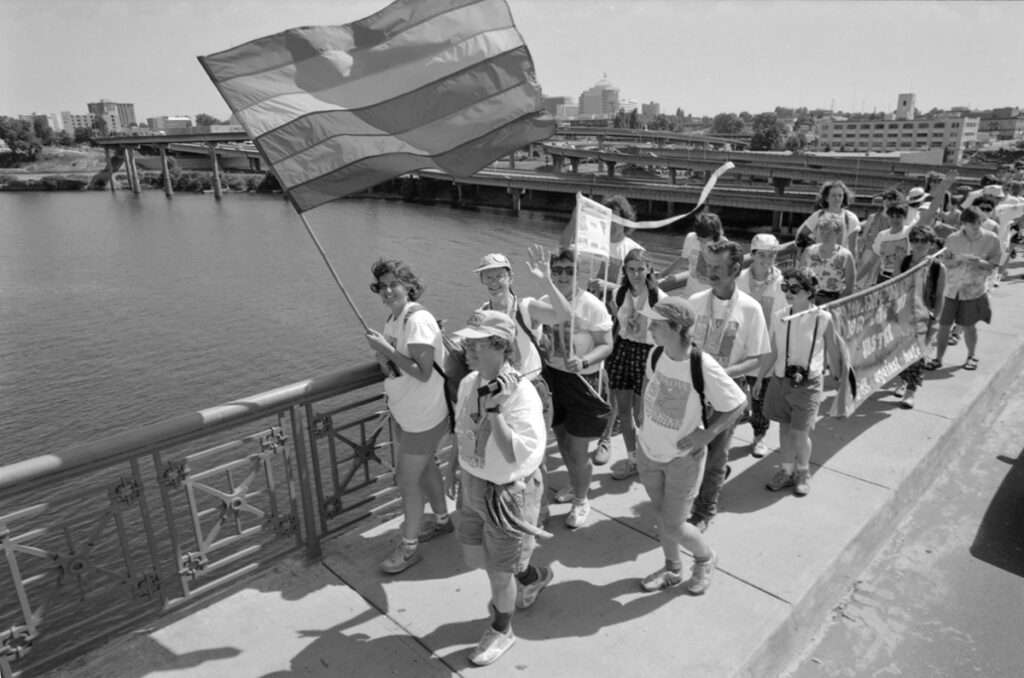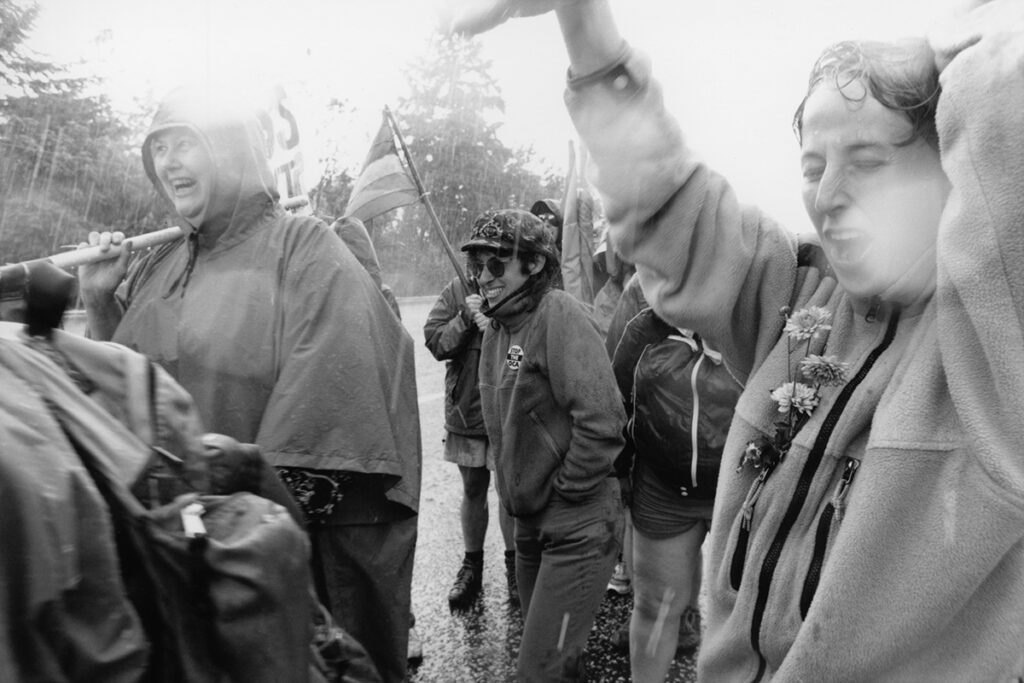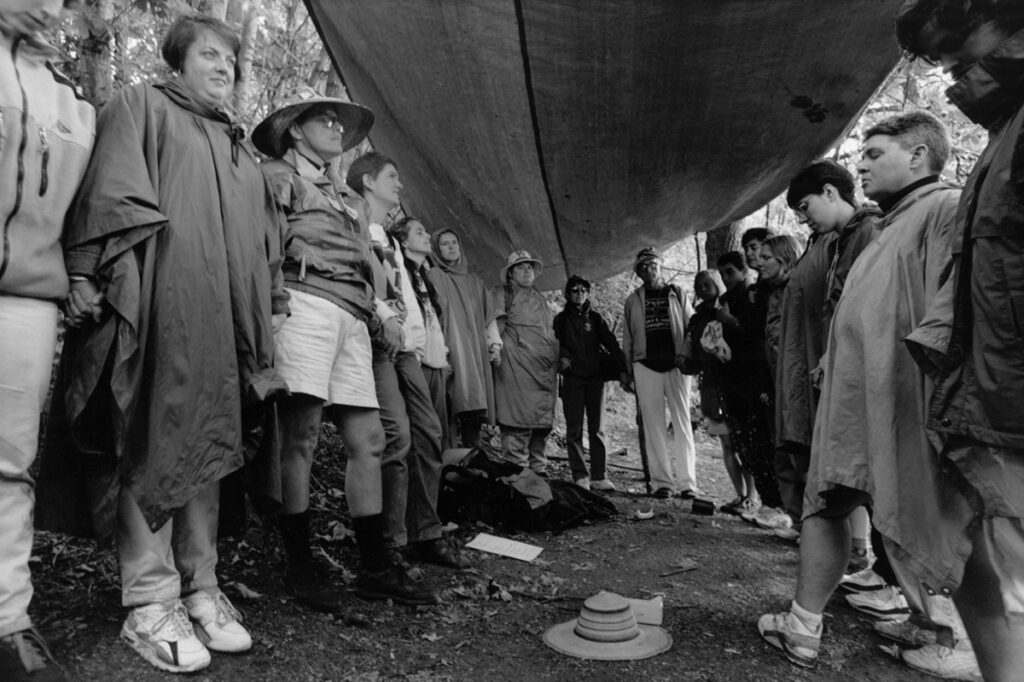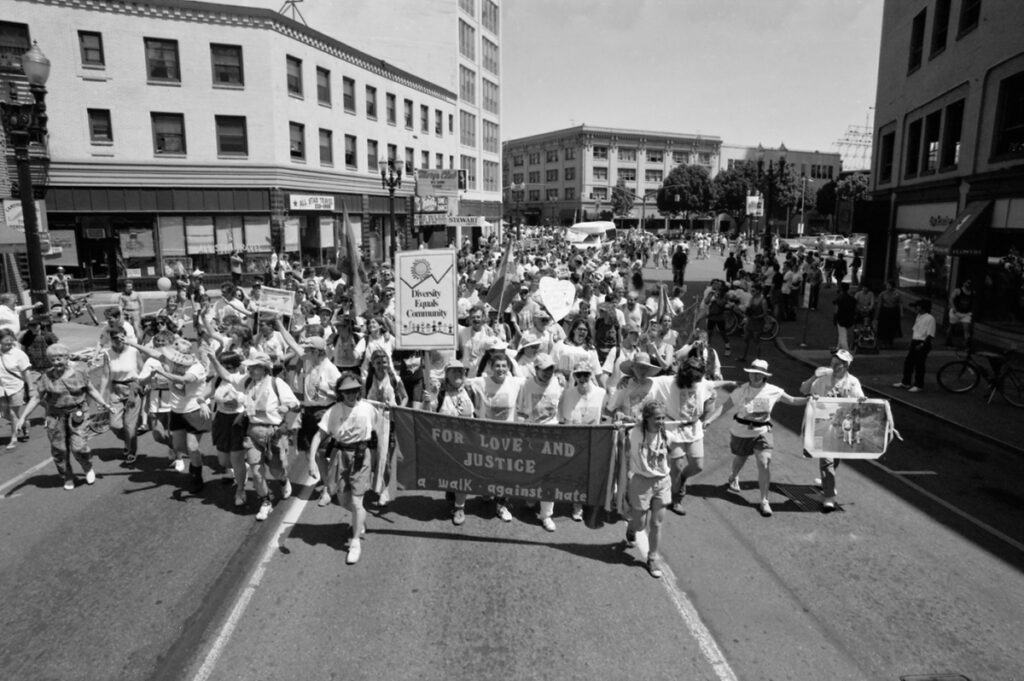“You are out on the front line of our movement. This Walk is about moral and spiritual values. You are walking in the tradition of the civil rights movement. You are not alone – every one of the 25 million American gays, lesbians, and bisexuals marches with you today.”
~ Urvashi Vaid (1958-2022), then executive director of the National Gay & Lesbian Task Force, at the kickoff rally for the Walk for Love & Justice
With those words, a contingent of Oregonians set out on foot, from Eugene, Oregon. They would walk 150 miles north, ending their two-week sojourn in the embrace of the Portland Pride march. They walked from June 7-20, 1992 under the banner: “For Love and Justice: A Walk Against Hate.”

Photo by Linda Kliewer.
The Walk for Love & Justice proclaimed, “We will walk proudly and with purpose – taking the agenda out of the hands of the OCA and going directly to the people of Oregon, asking them to stand with us for justice and against hate.”
Why are we walking? “The fundamental rights of lesbians and gays are under attack in Oregon from a right-wing group which we believe also threatens the rights of women, Jews, People of color, and the poor,” explained the bilingual fliers walkers carried to share with folks along the way. “We walk to build bridges and to promote an end to oppression and hatred in all of its forms including racism, sexism, homophobia and heterosexism.”
How can you help? “Talk to us. Find out who we are. Join us for an evening program. Invite your friends. Don’t sign the OCA’s petition. Vote against bigotry in November. Contribute to the Walk. HUMAN RIGHTS ARE NOT SPECIAL RIGHTS. More than 100 organizations, churches and synagogues, your friends and neighbors, have made this walk possible. Why don’t you join them? Why don’t you join us?”
Walking to Break Down Barriers
By the time Oregon faced the prospect of Ballot Measure 9, Anne Galisky says she “knew in my bones that long walks where you are vulnerable and exposed, where you depend on people for everything, for where to sleep at night, for every meal – that breaks down barriers all over the place.”
She had grown up in California, participating with a direct aid organization that worked in Tijuana, that had a 250 mile walk every year. “As a high school student, it was a social justice awakening for me to see the incredible value of just going out on the road receiving hospitality, meeting all kinds of people you wouldn’t have met otherwise,” Anne says. “And physically learning that doing a little bit each day, you can go a long way.”
Then in college she heard about a peace walk being planned from the Trident nuclear submarine base in Bangor, Washington to Washington, D.C. and then from Ireland to the occupied West Bank. “It was an absolutely life changing experience, as you can imagine,” Anne says.
“It’s this really quick intimacy, partially based on the vulnerability of being on the edge of the road. I saw with my own eyes, walking through all these different places – including Northern Ireland, at the height of the Troubles, and Israel and the West Bank, and Yugoslavia just a few years before war broke out there – you could have so many meaningful conversations. I just knew that a walk like this was a really valuable organizing tool.”
Anne Galisky
And so Anne proposed a walk across Oregon to the Lesbian Community Project. After some skepticism and debate, the board agreed to serve as the project’s sponsor – but Anne would have to assume all the risk and do all the work.
This was pre-internet, pre-email, pre-cell phone. Anne worked out of her attic bedroom on a borrowed typewriter, relying on the late-night discount at the neighborhood Kinkos for all her photocopying.
In her broken-down pickup truck she drove up and down the Willamette Valley, “having meetings with people and saying, ‘We’re going to do this. Can we sleep on your floor? We could have anywhere from 20 to 100 people needing a place to stay. Can you feed us? Will you write a letter of endorsement?”
One of the most important early meetings was with lesbians in Grants Pass. “They begged us not to have the walk go through Southern Oregon,” Anne says. “They told us, ‘If you do, someone will get killed.’” As she wrote in her post-event evaluation, “This meeting felt very valuable in terms of healing past wounds between Portland activists and southern Oregon rural lesbian and gay people. Listening to what rural activists need, instead of going in with a pre-set agenda, seems to be the way to go.”
Another pivotal meeting was with Cipriano Ferrel of PCUN, Oregon’s farmworkers union. He said, “Yes, you can stay here. Of course, we need you to learn about us.” The rest, as they say, is history. (Read more in our story, PCUN Union Hall.)
Not everyone was as open as PCUN. “There was so much fear,” Anne remembers.
“People who would say, ‘Yes, but we don’t want our name associated. You can sleep here but you can’t tell anyone.’ There was a lot of, ‘We don’t know what will happen to us if we help you.’ The feeling of the risks involved was very strong.”
Anne Galisky
“There was also so much courage,” says Anne. “Courage of the people who hosted us, and courage of the people who walked with us.”
While no one was harmed during the Walk, Anne says, “We did get death threats. We had stuff thrown at us. People screamed at us. When a car is slowing down, you don’t know what’s going to happen. Are they going to offer their support? Or are they going to shoot you?”
The walkers were prepared. They were in touch every day with law enforcement. And they had spent a day together in non-violent de-escalation training before departing. “We weren’t going in with some naivete that nothing’s going to happen,” Anne remembers. “The premise was, something would happen. And how are we going to handle it?”
Participant Ellen Goldberg’s response to the tension and danger still makes Anne laugh, 30 years later. “After having eggs thrown at us, she said, ‘You know I wanted eggs today, but I should have said I want eggs on a plate.’”

Hospitality as Social Change
The Walk for Love & Justice ended up being hosted, fed, or endorsed by more than 100 churches, synagogues, community organizations, and businesses. An exhaustive schedule of public programming along the route included appearances by elected officials, talks by state and national movement leaders, music, comedy, poetry readings, and rallies.
In her event report Anne wrote, “involving so many organizations turned out to be an important political tool. There is something very disarming about giving food and lodging to strangers. Hospitality, especially by providing a meal, is not viewed as a big commitment, but once people have eaten together and have heard each other’s stories, relationships begin – and with that comes a stake in each other’s wellbeing.”
A core group of about 20 walkers who did the full distance “helped with the feeling of continuity on the walk and did much of the leadership work,” Anne noted in her report. “However, people who walked for one or a few days made up the bulk of the numbers and provided some fresh energy.” As the Walk passed through larger population centers, it increased considerably in size, reaching the hundreds in its final miles into downtown Portland.
Thousands more were exposed to the message of the Walk through the extensive media coverage it attracted. Anne described the coverage as “quite plentiful and generally very positive: front page coverage with color photographs in daily papers of Eugene, Corvallis, Salem; included in a front-page story on Pride in Portland; newspapers in Woodburn, Estacada, Canby and Olympia; Associated Press, New York Times, Los Angeles Times; Oregon radio, NPR and Pacifica; local TV + national news coverage on NBC and ABC.”
The greatest lesson of the Walk, for Anne, is “that coming out changed everything. Allies had to choose. Queer folks had to choose. There was no neutral. The Measure 9 fight gave us an advantage in creating progressive institutions going forward, because we had accomplished something really hard by creating relationships with allies.”
“I went on the walk because I needed to do something… more than simply write letters. I needed to do something with my body. Something positive. Something transforming. I was transformed. I went believing that we are not supported by the vast majority of Oregonians. I learned the opposite! I learned that we have so many friends, if we only will reach out and express our need for support.”
The Rev. Marguerite Scroggie in The Lavender Connection
One Walker’s Story
Kelley Weigel was already deeply involved in the fight against the OCA but had to be talked into going on the Walk. She and Eric Ward were on the staff of the Community Alliance of Lane County (CALC – originally Clergy & Laity Concerned) based in Eugene, a liberal college town, that bordered the more conservative Springfield. Springfield was targeted by the OCA as a testing ground for their anti-gay ballot measures. They had succeeded in placing a local version of the statewide measure on the May 19 primary ballot.
As the secretary for the Lane County No on 9 organization, Kelley was putting all her effort into defeating the local measure and “didn’t see the point” of taking two weeks to walk to Portland. But CALC had signed on to support the Walk and its Eugene kickoff. Eric felt strongly that someone from their team needed to go. The BIPOC members of the staff didn’t see themselves walking down Oregon’s back roads. And then an out lesbian on the CALC board made her appeal to Kelley even more personal.
“She said, ‘You need you do this for me, because I can’t go’,” Kelley remembers. The board member was older, didn’t feel safe, and had to work.
Kelley got to go on paid work time. But, like all walkers, she was asked to raise contributions to cover costs. (Read her fundraising letter.) Her largest donation came from an unexpected source.
The day after the primary election, when a majority of Springfield voters approved the OCA’s local anti-gay measure, “there was a vigil at City Hall to mourn what happened,” Kelley remembers. “I’d been working really hard to defeat it, and I was crying. My picture ended up on the front page of the Eugene Register Guard – this young white girl, crying. The headline was, ‘Discriminatory measure passes Springfield.’
“Somehow my grandma and grandpa got a copy of that paper. They sent me $200 to go on the Walk. I had to raise $300. It wasn’t that much, but it was a lot for me and I didn’t know where it was going to come from. My grandma said, ‘We know how much this means to you, and so we want you to be able to go do it.’ I cry today just thinking about it. So I had everybody kind of pushing me to go.”
Kelley Weigel
Despite her initial skepticism about the Walk, Kelley looks back at the experience as “pretty profound – the walk serving as something of a pilgrimage to think about the things that need to change, and to make the space for that to happen, in a way that’s different from a march that lasts a few hours.
“It’s about creating an intentional community and the ways people can live in community, even if they don’t get along all the time. It was also about the basic needs that people have, making sure you have good organization and logistics so that those needs are met.”
It was also about having fun in challenging circumstances. “We sang the song ‘We are a gentle, angry people, about a billion times,” Kelley says. “Many of us joked at the end, that if we ever sang it again we’d have to change the lyrics, because how we really feel is, ‘We are fucking angry people!’”
On a more serious note, the Walk underscored “the importance of really being out, being visible for what you believe,” Kelley says, as a straight ally – and the courage that takes, “not knowing what’s going to be coming down the street at you, quite literally.”
After completing the Walk, Kelley recalled the trepidation she’d felt before it started. “I wondered how smart it was to walk through the heart of Oregon, challenging people’s ideas about gays and lesbians,” she wrote. But after the all-day non-violence training walkers participated in before setting off, “I realized I was with a group of people I could trust, and when I felt scared or angry, there would be someone there to help me get through that time.”
While Kelley doesn’t remember having any persuasive conversations with undecided or pro-OCA people along the Walk, she got a foretaste of the value of the “solidarity and connection with isolated pockets of people who, in their own communities, felt afraid to speak up against bigotry” that would become the signature “ROP thing.” (Kelley was co-director of the Rural Organizing Project from 1994-2002 before working at Western States Center for 15 years, including serving as its first female executive director.)
Last Days in the Service of his Values
One of the walkers who joined for a three-day stretch from Corvallis to Salem was a 78 year-old man named Isadore who had spent his life showing up for human rights.

In her report to her donors, Kelley described Isadore dancing along with a dozen other seniors at the Polk County Fairgrounds where walkers were serenaded by a song composed by their local hosts to the tune of “Onward Christian Soldiers” – “Walk for Love and Justice/ Walk in truth and pride/ We will walk together/ People side by side.”
“Inspiration has never had such concrete meaning,” Kelley wrote of that night with Isadore and their elder hosts.
After walking into Salem the next day, Isadore left the walkers at the rally, assuring them in a phone call that he was not feeling too well, but had had a great time and wished them well. They learned later that he had a fatal heart attack. The nurse who attended him said that he was glad he had gone on the walk, and he would do it again, even if it cost him his life.
“I hope my last days are spent in such a way,” Kelley says.

Learn More
- Watch Anne Galisky and Ramón Ramírez reflect on the impact of PCUN’s hosting the Walk for Love & Justice as panelists at the GLAPN event, “Lessons of Measure 9,” also featuring Kathleen Saadat and No on 9 Remembered Senior Fellow Holly Pruett.
- Read more of Ramón Ramírez’s recollections about the impact of the Walk in our story, PCUN Union Hall.
- View footage from the Walk in the feature documentary Ballot Measure 9.
- Check out pdfs of archival materials from the walk: statement from Walk Coordinator Anne Galisky; fundraising pitch letter from walker Kelley Weigel; Walk registration brochure; Join Us flier (bilingual); Daily Itinerary; Public Program Schedule; Eugene kickoff flier; Salem rally flier; Walk song sheets.
- Walk for Love & Justice Nonviolence Guidelines – For the purpose of building trust and a common foundation for safety, participants in the Walk are asked to agree to the following:
- Our attitude will be one of openness, friendliness, and respect toward all people we encounter.
- We will use no violence, verbal or physical, toward any person, even in the face of hostility.
- We will not damage any property.
- We will not bring or use drugs or alcohol other than for medical purposes.
- There will be no nudity during the walk, and everyone will keep their shirts on.
- We will carry no weapons.
- We will break no laws.
- We will cooperate with the police and Walk security team to ensure the safety of all participants and spectators.
As they say on The Moth Radio Hour, “Moth stories are true as remembered and affirmed by the storyteller.” Read more about the benefits and challenges of historical memory.
